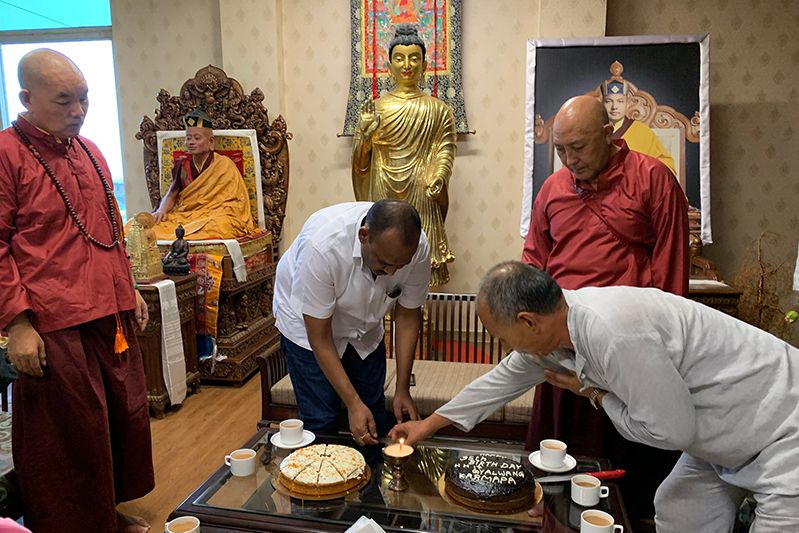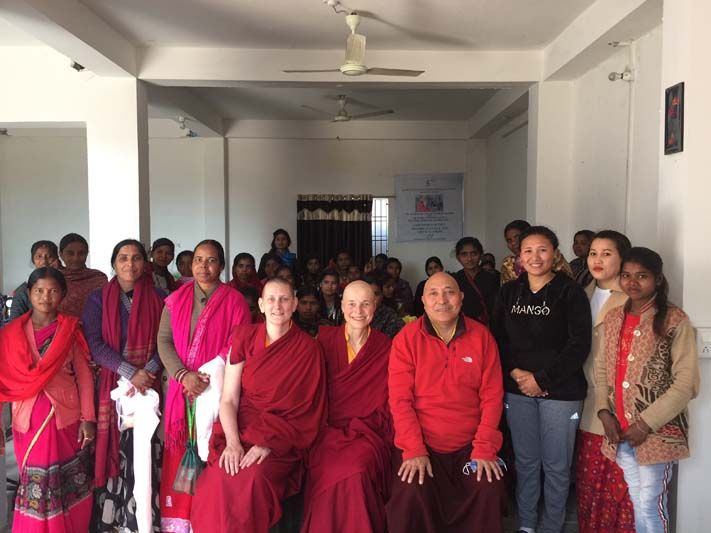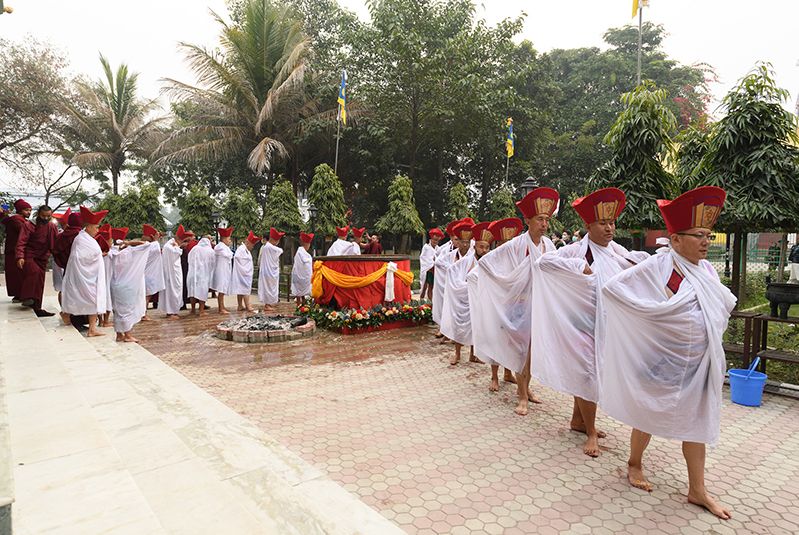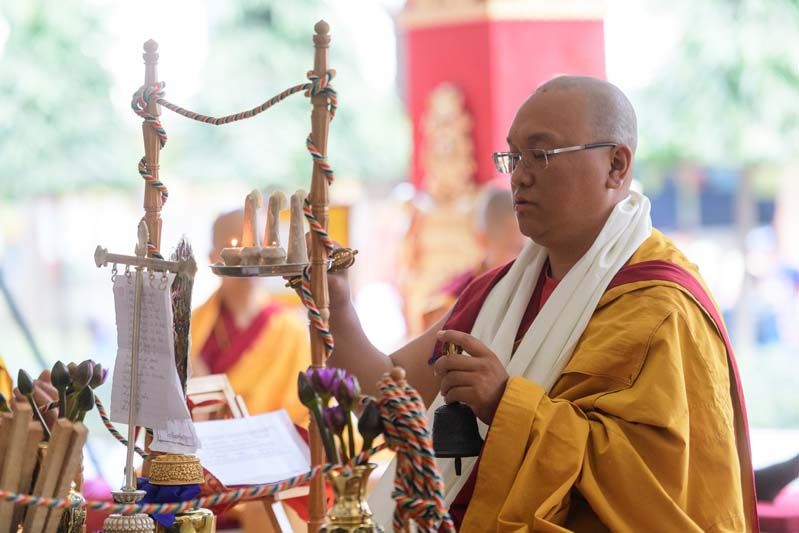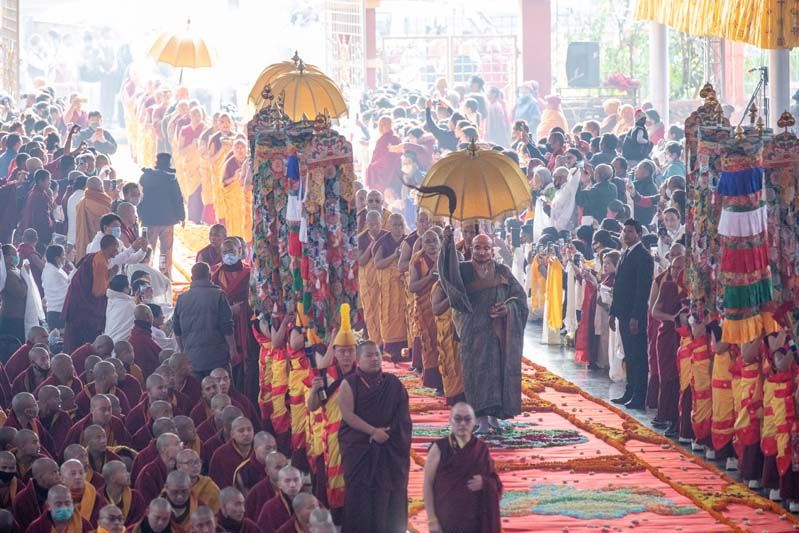A Talk on How We Should Practice
- January 5, 2009
January 05, 2009, By 17th Gyalwang Karmapa
Translated by Karma Choephel and Ven. Lhundup Damchö for Monlam English Translation Network.
In the Jataka Tales, it says:
After studying, make practice the essence. You will be freed from the stronghold of birth with little difficulty.
Similarly, the Teacher himself said in The Vinaya Scriptures:
There are two things that monastics should do: study through listening and contemplating, and abandon through meditation.
Gampopa said:
Beginners should study earnestly. After studying the teachings, practice earnestly.
As these explain, one should first listen to and contemplate the Dharma appropriately through scriptures and then make the practice of the meaning one has studied into the essence. This is the general way to uphold the teachings. The Buddha, out of kindness, said not once but over and over that his followers should emphasize practice, and uphold, preserve, and propagate the teachings of realization properly. Doing this is extremely important.
We can understand this when we read the biographies of Milarepa and Marpa the Translator and see what they did. They didn’t sit around like us, fat, happy, and enjoying themselves. They did such great practice that they meditated until their flesh was worn down to the bone. It is from this emphasis on practice that the name “Practice Lineage” was given, but it is not as if we do not have to do any study and contemplation. We should at the very least listen to and contemplate the lama’s instructions. Even if we cannot read the great philosophical texts, there is no way we can know how to meditate unless we study and contemplate the lama’s instructions thoroughly.
In order to meditate, it is very important to first identify what we are meditating on. If we meditate without identifying that, there is the danger it will become idiot meditation or idiot Dharma. If we do not first fully comprehend through listening and contemplating the meaning of what we are meditating on, how can we practice? Without something to practice or something to meditate on, we might say, “I’m practicing” or “I’m meditating,” but there would be the danger we end up betwixt and between, not anywhere at all. We would be neither in the world nor in the Dharma. We might try to look impressive, but because we are neither in the Dharma nor in the world, there is the danger that it could be said of us that we are caught betwixt and between.
Even if the forefathers of the practice lineage did not study philosophical texts in great detail, they did give their students naked or direct instructions on the experience they realized—the instructions of an old man pointing his finger, or symbolic pointing-out instructions. There is something special that happens when someone who has experience shows a physical expression or makes a slight gesture with their hands. After pointing out experience symbolically, there is a particular way to guide students down the path, which followers of the practice lineage must know. This is also what we call the meaning lineage of realization. Most of the lamas in the ranks of the Kagyu root and lineage lamas first attained a high level of scholarship before doing meditation practice, although there are some about whom I wonder whether they themselves did such study and contemplation of philosophy.
However, even if one does not have the breadth of study and contemplation, the experience of realization of the masters of the past can be pointed out nakedly or directly to students, so there is something special that happens. I think that if members of the practice lineage can recognize what the root and lineage masters have passed down and pointed out successively and what their root lama points out through the view of experience when actually instructing them, and then can make that the essence of their practice, they will uphold and preserve the teachings of the practice lineage over time, and they will also be able to help others develop and ripen.
Why is this? With Milarepa, for instance, first his lama Marpa pointed out the experience to him through signs, and he recognized it as it was given to him. Then he practiced whole-heartedly. When we read in his life story how he devoted himself one-pointedly to practice, it makes all of us cry tears of faith and devotion, whether we are members of the Sakya, Geluk, Kagyu, or Nyingma Dharma lineages, without any distinction. In his actions, his words corresponded to the meaning, so it makes us cry and none of us can help but feel faith and devotion. If the words and meaning did not correspond, it would be difficult for it to make us feel faith and devotion. All Sakyas, Gelukpas, Kagyus, and Nyingmas respect Milarepa without any partisan bias, yet there is no history at all of him studying extensively and writing many philosophical texts. However, Lama Milarepa himself said something like, “I have no material offerings to give, but I make this offering of practice to my father and mother lamas for the rest of my life.”
Milarepa recognized the experiential pointing-out instruction that Marpa gave him. After recognizing it, he made practice the main thing. That is how he became such a great being, able to benefit sentient beings by being seen, heard, remembered, or touched. When all of us merely hear his name, we feel a special kind of amazement. As a Nyingma lama once said, sometimes when our minds are disturbed and the afflictions are strong, other great texts do not help us, but reading The Way of the Bodhisattva and The Life of Milarepa helps a little bit. That’s how it is, isn’t it?
In any case, the person known as the author of The Life of Milarepa, the Bone Ornament Yogi or Crazy Heruka from Tsang, was a skilled writer. His writing is of extremely high quality. It strikes the heart and has feeling. Beginners can also get their minds around it. He is wonderful at touching us. Thus just by hearing The Life of Milarepa, Milarepa has become a great being who benefits the beings who merely see, hear, think of, or touch him.
In order to develop the view and meditation of the practice lineage or unmistaken meditation, we need to practice an unmistaken view. For that view, there is developing full comprehension of the view of the object, emptiness, as well as the preliminaries and the follow-through practices. The preliminary and follow-through practices are all similar, but the main practice has some distinct aspects. These are a different essence, different focus, different practice techniques, and the different power of the techniques, it is said. There are also two other distinct features of the main practice: different conditions for gaining realization and different ways of taking the path. According to the Dakpo Kagyu, the different way to develop realization is that because of the blessings of a lama who has directly realized the truth and the devotion of the student coming together, the student will directly realize the truth of the path of seeing. The different way to take the path is to take direct perception as the path rather than inference.
With the object, emptiness, those who primarily study the emptiness of the mahayana sutras realize it through logical proofs of the dharma nature, such as the king of reasonings, the proof of interdependence, and so forth. For the path and post-meditation as well, they follow the path primarily by way of inferential analysis, it is said. However, these are all only ways to guide disciples with differing natures and inclinations down the path, the great teachers said; there is no contradiction between them.
So we say that we are in the practice lineage, but really we are a bit of a disgrace to the practice lineage, aren't we? I wonder whether we are going to have anything from our practice to pass on in the lineage.
It is not okay not to have read the lives of the Kagyu forefathers. When we read them, we should be amazed. We need to look at ourselves. When we read the biographies of the forefathers of the practice lineage, we feel, "Oh no!" We call ourselves followers of the great masters of the practice lineage, but when we look at ourselves, forget about being a follower—I think we are just barely not disgracing them. There’s a danger we’ll have to rewrite the verse:
The venerable guru practices like that;
We who want freedom disgrace like that.
So when we read the lives of the gurus, we wonder whether our own behavior is compatible with the lives and deeds of the lamas. There is no point to being followers of the practice lineage in name only.
Actually, it was for practice that Lama Marpa and others underwent such difficulties and made such great efforts to go to India and receive empowerments and instructions in their entirety from genuine great Indian masters. They brought those back to the dark land of Tibet, translated them, and directly taught them to their students who practiced view, meditation, and conduct, handing them down just as a father gives his wealth to his child. They have given students or followers of our contemporary degenerate times hope and an opportunity to free themselves from the suffering of birth, aging, sickness, and death. Thus from one perspective we need to feel gratitude, and that is extremely important.
If we take Gelukpas as an example, individual monks have pictures of Tsongkhapa and his two main disciples in their rooms, which shows that they remember the kindness of their body, speech, and mind. It seems as if we Kagyupas are basically slowly forgetting about Marpa, Mila, and Gampopa, as I see it. In particular, we seem to think that the words of Milarepa that we recite these days come from the hand of a buddha who awakened to buddhahood in the past and then descended from Akanishta. We don’t think he was someone human like us. The lamas show the form of an ordinary sentient being, undergo difficulties, and make strong efforts to visibly demonstrate liberation for the benefit of the students, and we are throwing this away as if it were meaningless and unhelpful. This is a mistake. At the very least, if we don’t have the chance to practice, we need to be grateful, right?
To talk about it from a broader perspective, it is primarily the outer natural world—the plants, forests, and all the other things made up of the four elements—that supports our lives, makes it possible for us to breathe, gives us good health, and so forth. Any way you look at it, it is very beneficial to us. Thus we need to be grateful to it. Yet without the slightest bit of affection we destroy any plant that sends up a shoot or any slight bump in the ground, laying them waste.
Similarly, if we think about the inhabitants of this world, our food, clothing, beds, possessions, houses—in brief, anything at all that we might need is produced through the effort and difficulties of many sentient beings. It’s not as if our houses, nice clothes, and food are somehow just there from the time we are born. It is clear that all of these occur through one sentient being depending upon another.
From the smallest things on up, even the cup of tea we drank for breakfast depended upon many sentient beings in order to be made. Some of the butter in it may have arisen in dependence upon animals, and some in dependence upon plants. But just having a plant is not enough: there need to be many people to perform the actions of extracting the oil from the plant and pressing it. There are many people who are involved in selling it and bringing it to market. That is how it is: it has to pass through many people’s hands to get here. This is why whenever we drink a cup of tea, we first make a tea offering. It is good to be grateful like that, isn’t it?
If instead we just quickly gulp down a cup of tea without any thought or consideration, I wonder whether we are genuine mahayana practitioners. If we say we practice the mahayana, at the beginning of our meditation on bodhichitta, we remember that all beings have been our mothers. We are grateful. The gratitude of wanting to repay kindness is like the root of our mahayana attitudes and training, right? We should not just be grateful to humans. In brief, the physical environment and all the forests, plants, and everything else that comprise it, are all helpful to us. They sustain us. We should be grateful to them.
So this year the main theme of the Kagyu Monlam is gratitude. Last year the main thing was environmental protection. This year the main theme is gratitude. Thus it is extremely important for us to be grateful.
When we encounter the biographies of the forefathers of the practice lineage here now, we need to remember and keep firmly in mind how they underwent difficulties and gave up wrongdoing for the benefit of their future disciples. We can supplicate them again and again, but actually, we must wholeheartedly practice meditation on the points of their instructions. These two are very close. If we first develop a grateful attitude, then fifty percent has turned out well.
Therefore if we keep a grateful attitude in mind, I think that we will be able to uphold, preserve, and spread the teachings of the practice lineage. Otherwise, we will turn the Dharma into an empty façade. We’ll keep the Dharma from doing what it should and prevent the instructions from working, making the Dharma into even more of a façade. On the outside, it will appear as if we should be called Dharma practitioners, but if that appearance fools and deceives the faithful public, then just as Mao Tse Tung said, the Dharma will be poison. If the Dharma does not work as Dharma, there is a danger of fulfilling the prediction that Dharma will be the cause that throws us back into the lower realms.
Therefore we at least need to make sure that the Dharma doesn’t turn into poison. What we call Dharma is what we have to practice in order to free ourselves from the sufferings of the three realms of samsara. That is the sort of reason we do it. If we put aside liberation from samsara, we’ll be digging ourselves in deeper and deeper. If we mix Dharma with the eight worldly concerns, cling to discipline as paramount, and think too highly of our own view, there is the danger that we will dig ourselves ever more deeply and profoundly into samsara. That’s turning the Dharma inside out and upside down; it is not at all action that is compatible with the Dharma. Therefore, we need to take this to heart.
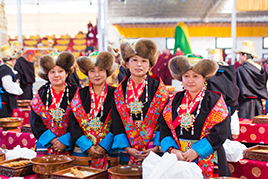
37th Kagyu Monlam Schedule
Tibetan / English / Chinese • French • German • Indonesian • Korean • Polish • Russian • Spanish • Vietnamese
Dharma Teachings
 Meditation Instructions
Meditation Instructions
Recorded during the 37th Kagyu Monlam, Bodhgaya, India. January 28-30, 2020.

